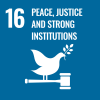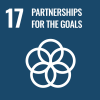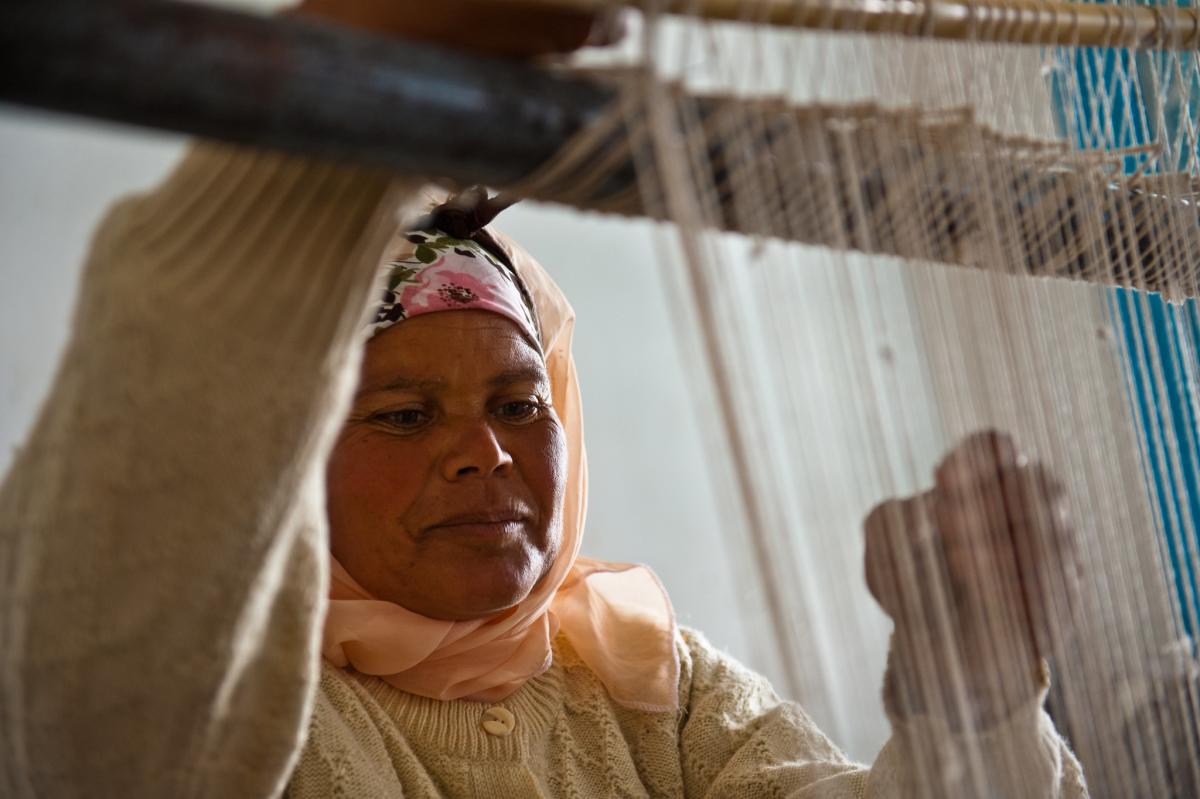
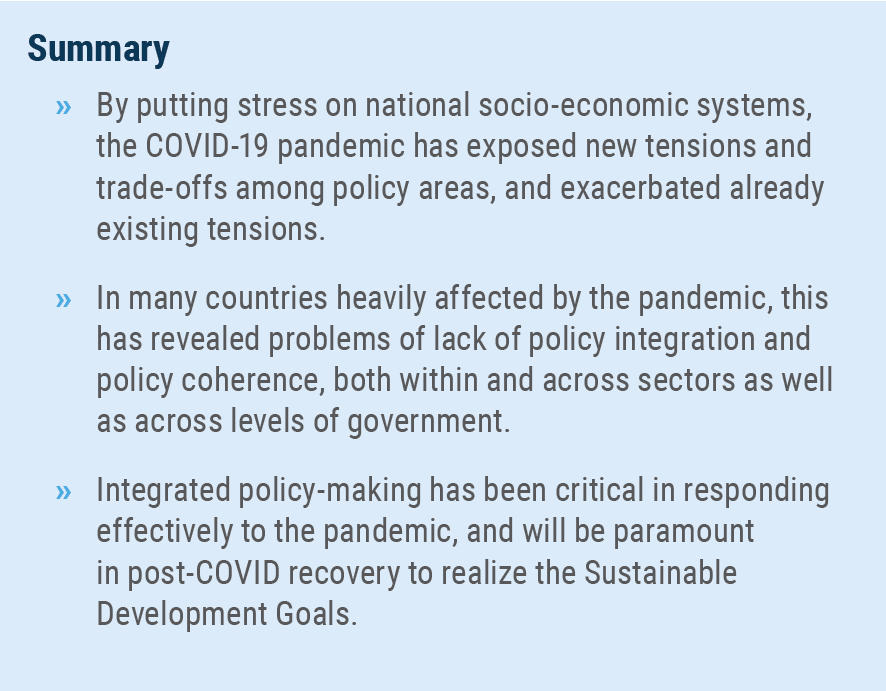 Policy integration is one of the fundamental tenets of sustainable development. The integration of economic, social and environmental dimensions was put forward in Agenda 21, the outcome of the Earth Summit in 1992, and remained a key concern of subsequent international conferences on sustainable development, until the Rio+20 conference. The 2030 Agenda for Sustainable Development and its Sustainable Development Goals (SDGs) have put considerations of policy integration and policy coherence on a new level, by emphasizing indivisibility and interdependence among the goals and targets. The preamble of the 2030 Agenda states: “The interlinkages and integrated nature of the Sustainable Development Goals are of crucial importance in ensuring that the purpose of the new Agenda is realised”. Since the 2030 Agenda was agreed, policy coherence and policy integration have been present at the forefront of policy discussions, from the global to the national level. In its recent resolution on the follow-up and review of the 2030 Agenda, the General Assembly of the United Nations emphasized the need to “strengthen the analysis of the interlinkages across the Sustainable Development Goals and targets, including policy implications of their synergies and trade-offs”. Integration is about effectively addressing tensions and trade-offs that exist across policy areas, as well as exploiting synergies among those. It can be analyzed through multiple lenses. This policy brief focuses on horizontal integration, which refers to the capacity of government departments in charge of different policy issues to work together; and vertical integration, which refers to consistency, coordination and collaboration across different levels of government. By putting stress on multiple parts of national socio-economic systems at the same time, the COVID-19 pandemic has exposed new tensions and trade-offs among policy areas and exacerbated already existing tensions. While the pandemic has shown the importance of coordinating policy interventions in various policy areas, in many countries, governments’ responses to the crisis have revealed lack of policy integration, both across policy areas and across levels of government, which has hampered their effectiveness. The need for policy integration in the context of COVID-19 is apparent at multiple levels, from individual sectors to whole-of-society, macroeconomic issues. Tensions at the latter level are becoming more acute as the pandemic lingers and its adverse economic and social impacts continue to unfold. This brief highlights three society-wide issues that will require integrated approaches to respond effectively to the pandemic and achieve the SDGs post-COVID. It also examines challenges of vertical integration in the context of the pandemic and beyond. Finally, it touches upon lessons learned from institutional mechanisms put in place by countries during the pandemic to enhance policy integration.
Policy integration is one of the fundamental tenets of sustainable development. The integration of economic, social and environmental dimensions was put forward in Agenda 21, the outcome of the Earth Summit in 1992, and remained a key concern of subsequent international conferences on sustainable development, until the Rio+20 conference. The 2030 Agenda for Sustainable Development and its Sustainable Development Goals (SDGs) have put considerations of policy integration and policy coherence on a new level, by emphasizing indivisibility and interdependence among the goals and targets. The preamble of the 2030 Agenda states: “The interlinkages and integrated nature of the Sustainable Development Goals are of crucial importance in ensuring that the purpose of the new Agenda is realised”. Since the 2030 Agenda was agreed, policy coherence and policy integration have been present at the forefront of policy discussions, from the global to the national level. In its recent resolution on the follow-up and review of the 2030 Agenda, the General Assembly of the United Nations emphasized the need to “strengthen the analysis of the interlinkages across the Sustainable Development Goals and targets, including policy implications of their synergies and trade-offs”. Integration is about effectively addressing tensions and trade-offs that exist across policy areas, as well as exploiting synergies among those. It can be analyzed through multiple lenses. This policy brief focuses on horizontal integration, which refers to the capacity of government departments in charge of different policy issues to work together; and vertical integration, which refers to consistency, coordination and collaboration across different levels of government. By putting stress on multiple parts of national socio-economic systems at the same time, the COVID-19 pandemic has exposed new tensions and trade-offs among policy areas and exacerbated already existing tensions. While the pandemic has shown the importance of coordinating policy interventions in various policy areas, in many countries, governments’ responses to the crisis have revealed lack of policy integration, both across policy areas and across levels of government, which has hampered their effectiveness. The need for policy integration in the context of COVID-19 is apparent at multiple levels, from individual sectors to whole-of-society, macroeconomic issues. Tensions at the latter level are becoming more acute as the pandemic lingers and its adverse economic and social impacts continue to unfold. This brief highlights three society-wide issues that will require integrated approaches to respond effectively to the pandemic and achieve the SDGs post-COVID. It also examines challenges of vertical integration in the context of the pandemic and beyond. Finally, it touches upon lessons learned from institutional mechanisms put in place by countries during the pandemic to enhance policy integration.
Horizontal integration: the pandemic has exposed tensions and trade-offs among policy areas
Horizontal integration—the capacity of government departments to work together—has emerged as a critical requirement in the context of the pandemic. Managing the spread of the epidemic, implementing the measures adopted to combat it and their progressive lifting requires coordinating policies and actions across policy areas as diverse as health, policing, public transport, education, economic policy, trade, tourism, and a range of social safety nets. In addition to national governments, local governments have played critical roles in addressing the pandemic and its impacts through policy integration, by shifting resources between task areas and addressing the crisis from a holistic territorial perspective. In order to illustrate the challenges caused by the pandemic in terms of horizontal integration, this section focuses on three dilemmas: managing the trade-off between containing the virus and keeping economies open; limiting and counteracting the impacts of the pandemic and policy responses to it on inequality; and inter-generational equity.
Managing the trade-off between containing the virus and keeping economies open
Perhaps the biggest question facing governments in countries heavily affected by COVID-19 has been that of managing the tensions between keeping the pandemic under control and keeping national economies afloat. The example of many European countries, which reopened their economies including the tourism sector after the first wave of the pandemic, has shown how difficult it is to find a balance between the two. Many countries where the diffusion of the virus was thought to be under control by June 2020 later entered second waves, in some cases more massive than the first. This, in turn, led to partial closures of economies. Governments have managed this tension in different ways, even among countries at similar levels of development. Within individual countries, the tension between the two objectives has evolved over time. The trade-off has been clearly perceived by people and the press alike. Governments have faced pressure from interest groups and individual citizens to keep economies open, while many have experienced intense debate within government over the pace and intensity of public health measures that limit economic activity. Beyond finding effective means to durably control the spread of the virus, there are no easy solution to resolving this tension. In societies that are not able to control the spread of the virus, cycles of contagion, lockdown, reopening of economies, leading again to increased contagion, could be expected until large proportions of national populations are vaccinated.
Limiting and counteracting the impacts of the pandemic and policy responses to it on inequality
Limiting and counteracting the impacts of the pandemic and policy responses to it on inequality is another issue that demands policy integration. In general, the pandemic has been shown to negatively impact the most vulnerable groups and individuals more, thereby tending to aggravate existing inequalities. This has been observed in developed as well as developing countries. With regard to the health impacts of the pandemic, populations that were already marginalized have been rendered especially vulnerable, due to socioeconomic disadvantage, weak access to healthcare, and patterns of discrimination and disadvantage. But what makes this a policy integration issue is that negative impacts of the pandemic affect vulnerable groups in multiple dimensions, including jobs, education, access to health, and other basic needs and rights. For instance, low-income groups have lower access to the internet, and are less likely to be reached by online education systems put in place during the pandemic. Ethnic minorities and other excluded groups have often faced disproportionate health risks while bearing disproportionate economic impacts. 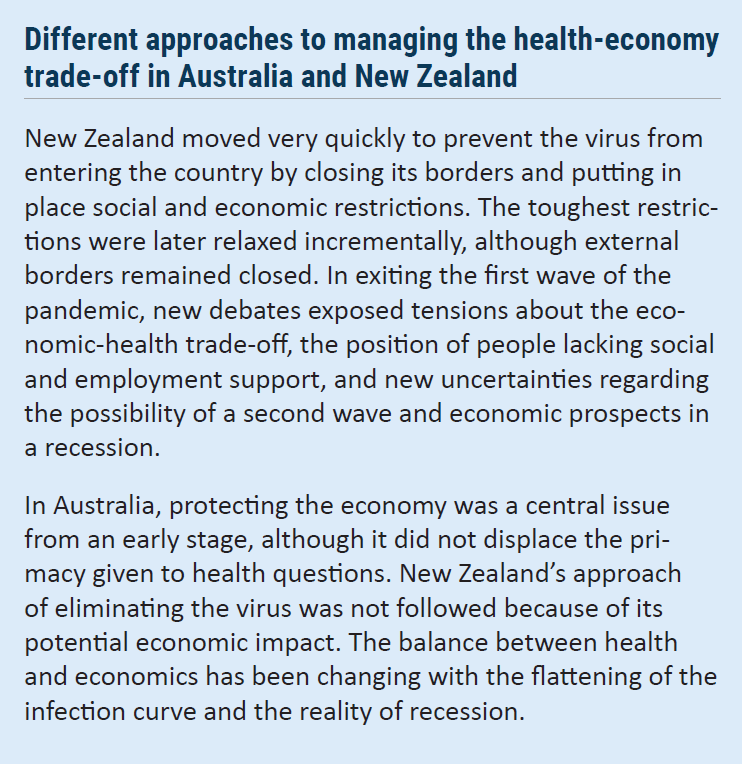 Addressing the compound effects of the pandemic on multiple vulnerabilities requires integrated policies. Policy responses in many countries may have fallen short of this, being limited to collections of sectoral measures which, taken together, may not be sufficient. Worryingly, there is a risk that the lifting of support measures adopted during the pandemic, if not done carefully, could exacerbate inequalities further, for instance in relation to gender as countries end measures that supported fee-free child care arrangements. Many countries lack the social protection systems needed to mitigate the vulnerabilities at play, with a large majority of the population having very little protection from social or economic risk in normal times. In 2019, 55 percent of the world’s population were unprotected by a single social protection benefit, with women less likely than men to have access to safety nets such as unemployment insurance. During the pandemic, many countries have implemented emergency interventions to tackle these gaps. According to the World Bank, by September 2020, more than 200 countries and territories had put in place over 1,000 social protection measures, with average expenditures per capita at levels well above levels seen during the 2008 financial crisis. However, the majority of those social protection measures are temporary. As in the wake of the 2008 financial crisis, countries face challenges regarding financial sustainability, with a financing gap of $1.2 billion in 2020 for providing universal social protection coverage, or 3.8 percent of developing-country GDP. The pandemic may mark an acceleration of the push towards universal protection through the lifecycle, as countries institutionalize temporary measures, continue to expand coverage to excluded groups, and mainstream participatory mechanisms for program design and accountability. Alternatively, many governments may limit their efforts to providing minimalist ‘safety nets’ and stopgap measures during a period of fiscal retrenchment, leaving large gaps in protection that would reduce resilience to future crises.
Addressing the compound effects of the pandemic on multiple vulnerabilities requires integrated policies. Policy responses in many countries may have fallen short of this, being limited to collections of sectoral measures which, taken together, may not be sufficient. Worryingly, there is a risk that the lifting of support measures adopted during the pandemic, if not done carefully, could exacerbate inequalities further, for instance in relation to gender as countries end measures that supported fee-free child care arrangements. Many countries lack the social protection systems needed to mitigate the vulnerabilities at play, with a large majority of the population having very little protection from social or economic risk in normal times. In 2019, 55 percent of the world’s population were unprotected by a single social protection benefit, with women less likely than men to have access to safety nets such as unemployment insurance. During the pandemic, many countries have implemented emergency interventions to tackle these gaps. According to the World Bank, by September 2020, more than 200 countries and territories had put in place over 1,000 social protection measures, with average expenditures per capita at levels well above levels seen during the 2008 financial crisis. However, the majority of those social protection measures are temporary. As in the wake of the 2008 financial crisis, countries face challenges regarding financial sustainability, with a financing gap of $1.2 billion in 2020 for providing universal social protection coverage, or 3.8 percent of developing-country GDP. The pandemic may mark an acceleration of the push towards universal protection through the lifecycle, as countries institutionalize temporary measures, continue to expand coverage to excluded groups, and mainstream participatory mechanisms for program design and accountability. Alternatively, many governments may limit their efforts to providing minimalist ‘safety nets’ and stopgap measures during a period of fiscal retrenchment, leaving large gaps in protection that would reduce resilience to future crises.
Inter-generational equity as a policy coherence issue
The COVID-19 pandemic has highlighted intergenerational equity issues in an acute way. The death toll from the virus has been much higher for older persons than for middle-aged and young persons. Many public health systems were initially taken off guard as regards older persons living in nursing and retirement homes, where high mortality rates were observed and linked with lack of effective strategies to prevent the spread of the virus and to treat infected patients. Negative impacts of the pandemic on older people have included denial of health care for conditions unrelated to COVID-19; neglect and abuse in institutions and care facilities; increases in poverty and unemployment; impacts on well-being and mental health; and the trauma of stigma and discrimination. The loss of large numbers of older people, among other things, entails the loss of human capital and deprives societies from the work, child care, community support and social and cultural contributions provided by older people. Young people have also faced adverse impacts from the crisis, with gaps in education, more difficult entry in active life, and rises in unemployment, among others. COVID-19 has exacerbated educational inequality, with the pandemic causing “the largest disruption of education systems in history.” At the peak of the first wave of the virus, 1.6 billion children and young people were out of school and university – over 90 percent of the world’s total – with a four-month school closure expected to cost learners $10 trillion in lifetime earnings. Finance is likely to be diverted from the sector, with the World Bank predicting a “triple funding shock” as governments, households, and international donors cut expenditure. At a macroeconomic level, the impacts of the crisis have affected the transfer of resources between generations, including the fiscal flows upon which many countries base the financing of their pension systems. These negative impacts are already visible in some countries. More broadly, the economic shock caused by the pandemic has resulted at the same time in a decline of government revenues and in additional expenditures, as governments have had to spend in critical sectors. To mitigate the negative impacts of partial closures of national economies, governments resorted to extensive fiscal support measures. Governments across the world have now put in place even larger recovery packages. Beyond questions of financial sustainability, these fiscal measures carry high opportunity costs, as spending today decreases the fiscal and policy space that will be available to future generations. This, by itself, could put the realization of the SDGs in peril. It is therefore of utmost importance to ensure that the recovery packages that governments are putting in place are aligned with long-term actions that support the delivery of the SDGs. Among other things, ensuring government accountability on those expenditures will be critical. Addressing issues of inter-generational equity in the recovery phase of the pandemic will entail delicate balancing acts, which will ideally need to be widely consulted within each country.
Vertical integration: challenges in coordinating government responses across levels of government
Local governance has been stressed as a key dimension for the implementation of the 2030 Agenda. The COVID-19 pandemic has caused severe challenges for governance at the city level. It has negatively impacted the capacity of local governments to deliver critical functions, including the provision of many services for which they are at the front line. Vertical integration has been a key challenge in developments observed thus far, in all regions of the world. The pandemic forced multiple levels of government to work together, with subnational authorities playing an essential role. Coordination across levels of government was critical in order to ensure coherence in response measures, support local health systems that are at the front line, and ensure the delivery of assistance packages to local communities. Lack of vertical integration can cause disruptions in all these areas, especially when responsibilities are left unclear. Completely decentralized approaches can force sub-national and local governments to compete against each other for critical equipment, as observed during the first months of the pandemic in several countries. Decisions taken by the central government without consultation with lower levels of government can create confusion on the rules that apply and the strategies to follow, sometimes creating major social issues for local governments, as observed in countries where lockdowns forced thousands of informal workers to leave cities where they could not work anymore. Countries have experimented with ways to enable local governments to respond to the crisis more effectively. In the Republic of Korea, the Korea Center for Disease Control and Prevention (KCDC) responded to a massive local outbreak in the city of Daegu by granting local authorities more power, allowing them to take action without first reporting to the KCDC. This strategy facilitated rapid testing and quickly breaking the local chain of transmission. 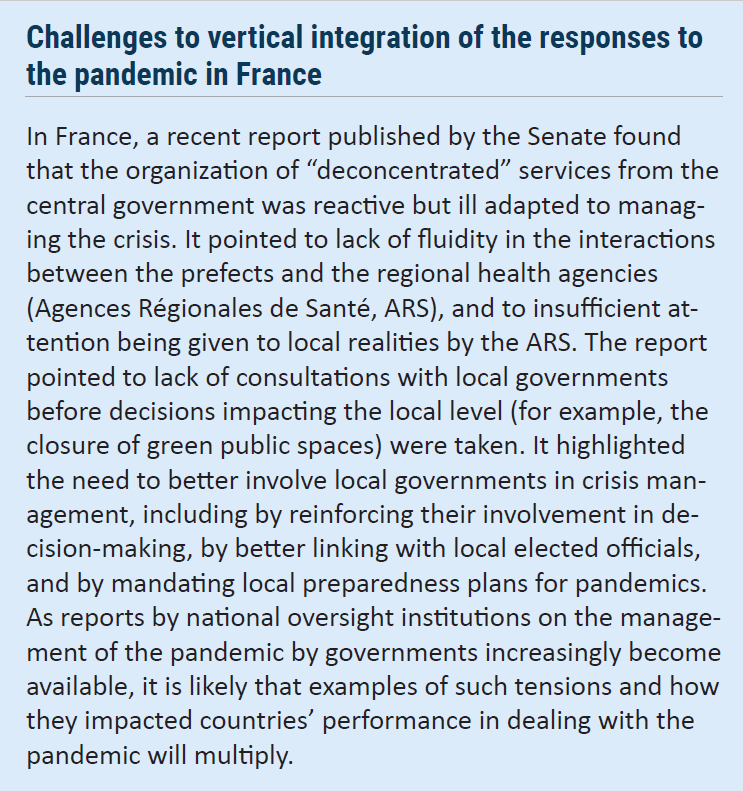 As a sector that was heavily impacted by the pandemic in all countries, education has offered examples of the tensions that can arise among levels of governments in crisis situations. From an institutional perspective, education is a complex sector, as its delivery often involves two or more layers of government, from the most local where education is delivered, to various intermediary levels of government to the national government, which interact on educational mandates, curricula, budgets, taxes and subsidies, teacher training and mobility issues, and safety issues, among many others. The pandemic, by forcing whole education systems to abruptly shift to remote learning, has raised issues in all these dimensions. The costs of providing education in the pandemic context have tended to be higher than in normal times, while resources available to governments were decreasing. In some countries, this has been a source of tensions between levels of governments. The coordination of responses to the pandemic across levels of government is shaped by the frameworks that govern the relationships between them. Those vary considerably across countries, going from very centralized models to highly decentralized ones. Within countries, they are also subject to changes in cases of national emergencies. For instance, in the federal government structure of India, health is a subject that falls within the jurisdiction and authority of the provinces or states. To tackle the pandemic, the provisions of the National Disaster Management legislation were invoked and power vested to the national government to issue orders, guidelines and protocols, which the states must follow. In many countries, the balance between a perceived need for coordinated action across all levels of governments and the need for flexibility in local responses appears to have fluctuated over time. For instance, in Germany, an initial phase of relatively uncoordinated and decentralized containment measures adopted by states and local governments was followed by a phase where more vertically and horizontally coordinated actions were taken in compliance with the recommendations of the federal authority (Robert Koch Institute). In some countries with highly decentralized systems, joint guidelines to be followed at different levels of government were issued as a way to bypass the impossibility for the central government to impose decisions on lower levels of governments. In Norway, in late March 2020, 134 municipalities established local restrictions on movement into the municipalities or regions to avoid infections in areas with low health care capacity. The national government at first did not recommend these local rules. Then national guidelines were established that had strong support from employers’ and employees’ organizations, but the government stopped short of making them mandatory, which meant that some municipalities stuck to their local rules. Sub-national governments have faced financial difficulties since the pandemic began. This has resulted both from the loss of revenues from own sources and from the sharing of national taxes. Concomitantly, many local governments have faced the need for increased expenditures in order to fight the pandemic, for instance in the health and education sectors. In some countries, the central government stepped in and provided support to local governments to compensate lost revenues. In other cases, central government decisions drew controversy among municipal leaders as local governments lost important revenue sources. Lack of vertical integration of responses to the virus in many countries has been linked to political tensions among the various levels of government. In some cases, heavily centralized responses stemmed from the prevailing political and administrative culture. In others, tensions have been linked to recent or ongoing decentralization reforms, or to states of civil unrest or post-conflict, with low levels of trust among public officers at different levels impeding collaboration among different tiers of the government. In several countries, the tensions between levels of government became part of a “blame game” to deflect the responsibility about the performance of the government in managing the response to the pandemic. Such situations have sometimes resulted in efforts from different levels of public administration counteracting one another. Civil servants had to mitigate these political and administrative tensions. They also had to find innovative solutions to incompatible administrative processes. The lessons from the pandemic in terms of the capacity of States to manage similar crises in the future do not seem to yield simple responses in terms of the degree of decentralization that works best. On the one hand, some experts have highlighted the difficulties inherent in coordinating responses across different levels of government. They have pointed to gaps between the organization of crisis responses as codified in national law, and what has happened during the pandemic. On the other hand, examples from highly decentralized countries such as Germany and Norway have shown that a high degree of coordination on decisions affecting public health and civil liberties could be achieved through concertation. It has also been pointed out that even in situations of political tensions between layers of government, the competition among them has sometimes resulted in welfare enhancing initiatives.
As a sector that was heavily impacted by the pandemic in all countries, education has offered examples of the tensions that can arise among levels of governments in crisis situations. From an institutional perspective, education is a complex sector, as its delivery often involves two or more layers of government, from the most local where education is delivered, to various intermediary levels of government to the national government, which interact on educational mandates, curricula, budgets, taxes and subsidies, teacher training and mobility issues, and safety issues, among many others. The pandemic, by forcing whole education systems to abruptly shift to remote learning, has raised issues in all these dimensions. The costs of providing education in the pandemic context have tended to be higher than in normal times, while resources available to governments were decreasing. In some countries, this has been a source of tensions between levels of governments. The coordination of responses to the pandemic across levels of government is shaped by the frameworks that govern the relationships between them. Those vary considerably across countries, going from very centralized models to highly decentralized ones. Within countries, they are also subject to changes in cases of national emergencies. For instance, in the federal government structure of India, health is a subject that falls within the jurisdiction and authority of the provinces or states. To tackle the pandemic, the provisions of the National Disaster Management legislation were invoked and power vested to the national government to issue orders, guidelines and protocols, which the states must follow. In many countries, the balance between a perceived need for coordinated action across all levels of governments and the need for flexibility in local responses appears to have fluctuated over time. For instance, in Germany, an initial phase of relatively uncoordinated and decentralized containment measures adopted by states and local governments was followed by a phase where more vertically and horizontally coordinated actions were taken in compliance with the recommendations of the federal authority (Robert Koch Institute). In some countries with highly decentralized systems, joint guidelines to be followed at different levels of government were issued as a way to bypass the impossibility for the central government to impose decisions on lower levels of governments. In Norway, in late March 2020, 134 municipalities established local restrictions on movement into the municipalities or regions to avoid infections in areas with low health care capacity. The national government at first did not recommend these local rules. Then national guidelines were established that had strong support from employers’ and employees’ organizations, but the government stopped short of making them mandatory, which meant that some municipalities stuck to their local rules. Sub-national governments have faced financial difficulties since the pandemic began. This has resulted both from the loss of revenues from own sources and from the sharing of national taxes. Concomitantly, many local governments have faced the need for increased expenditures in order to fight the pandemic, for instance in the health and education sectors. In some countries, the central government stepped in and provided support to local governments to compensate lost revenues. In other cases, central government decisions drew controversy among municipal leaders as local governments lost important revenue sources. Lack of vertical integration of responses to the virus in many countries has been linked to political tensions among the various levels of government. In some cases, heavily centralized responses stemmed from the prevailing political and administrative culture. In others, tensions have been linked to recent or ongoing decentralization reforms, or to states of civil unrest or post-conflict, with low levels of trust among public officers at different levels impeding collaboration among different tiers of the government. In several countries, the tensions between levels of government became part of a “blame game” to deflect the responsibility about the performance of the government in managing the response to the pandemic. Such situations have sometimes resulted in efforts from different levels of public administration counteracting one another. Civil servants had to mitigate these political and administrative tensions. They also had to find innovative solutions to incompatible administrative processes. The lessons from the pandemic in terms of the capacity of States to manage similar crises in the future do not seem to yield simple responses in terms of the degree of decentralization that works best. On the one hand, some experts have highlighted the difficulties inherent in coordinating responses across different levels of government. They have pointed to gaps between the organization of crisis responses as codified in national law, and what has happened during the pandemic. On the other hand, examples from highly decentralized countries such as Germany and Norway have shown that a high degree of coordination on decisions affecting public health and civil liberties could be achieved through concertation. It has also been pointed out that even in situations of political tensions between layers of government, the competition among them has sometimes resulted in welfare enhancing initiatives.
Institutional structures put in place by countries during the pandemic to strengthen policy integration
At the start of the pandemic, most countries put in place inter-departmental coordination mechanisms. Such mechanisms operated at different levels, from high-level coordination structures to working level mechanisms, including thematic task forces and committees with representation from relevant government agencies and various levels of government. In some countries, specific structures and mechanisms were put in place to develop pandemic management and response plans with indigenous peoples, reflecting the need for tailored approaches that had been identified during previous pandemics. 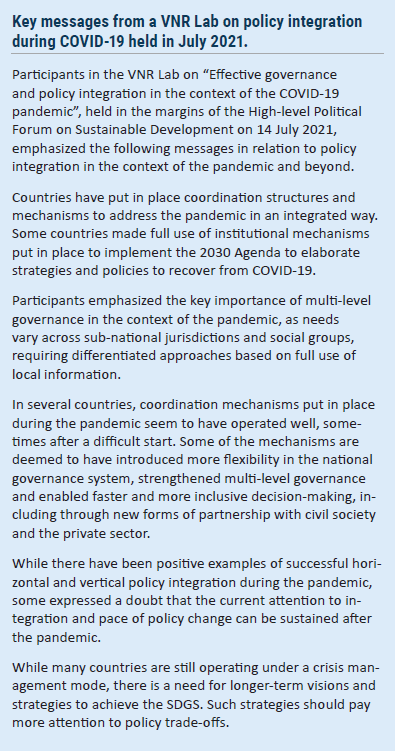 While some countries made use of mechanisms foreseen in their legislation on crisis management, many mechanisms were new. Their performance has started to be assessed through academic articles and reports produced by parliaments and other national oversight institutions that looked at the performance of governments in managing the pandemic. Informal communications from country representatives in the margin of the 2021 edition of the High-level Political Forum on Sustainable Development have pointed to interesting lessons from those mechanisms. In some cases, the coordination structures put in place during the pandemic have acquired a permanent status. For instance, in Australia, the National Cabinet, an intergovernmental forum put in place in March 2020 to manage and coordinate the federal, state and territory responses to COVID-19, has since May 2020 replaced the previous intergovernmental forum, the Council of Australian Government.
While some countries made use of mechanisms foreseen in their legislation on crisis management, many mechanisms were new. Their performance has started to be assessed through academic articles and reports produced by parliaments and other national oversight institutions that looked at the performance of governments in managing the pandemic. Informal communications from country representatives in the margin of the 2021 edition of the High-level Political Forum on Sustainable Development have pointed to interesting lessons from those mechanisms. In some cases, the coordination structures put in place during the pandemic have acquired a permanent status. For instance, in Australia, the National Cabinet, an intergovernmental forum put in place in March 2020 to manage and coordinate the federal, state and territory responses to COVID-19, has since May 2020 replaced the previous intergovernmental forum, the Council of Australian Government.
Conclusion
Policy integration and policy coherence will be more needed than ever to realise the SDGs post-COVID. Among the key questions for governments is how to keep sight on the SDGs and how to preserve the policy and fiscal space to achieve the needed transformations to achieve them, while continuing to respond to the pandemic and managing recovery. Many governments are facing competing demands on their resources and compelling reasons to prioritize some objectives over others. While the choices of governments in this regard will depend on a country’s context and circumstances, one key area of attention should be the articulation of the public expenditures that are made under emergency measures to respond to and recover from COVID-19, and the longer-term strategies and plans to deliver on the SDGs. Countries heavily affected by the virus are facing a number of policy trade-offs, which they will have to address going forward. In many countries, the associated arbitrages are likely to become increasingly difficult due not only to accumulated public debt and reduced policy space, but also because of sustained increases in poverty and inequality, as well as accumulated public frustration. Engaging the whole of society in discussing the trade-offs and opportunities ahead and finding consensual ways to address them should be an overarching concern for governments in coming months. With regard to vertical integration, institutional changes effected during the pandemic in many countries may result in changes in the balance of powers among levels of government, both during crises and in “normal” times. It remains to be seen how this could foster a culture of concertation and cooperation across government levels, and ultimately impact the realization of the Sustainable Development Goals.
 Welcome to the United Nations
Welcome to the United Nations
